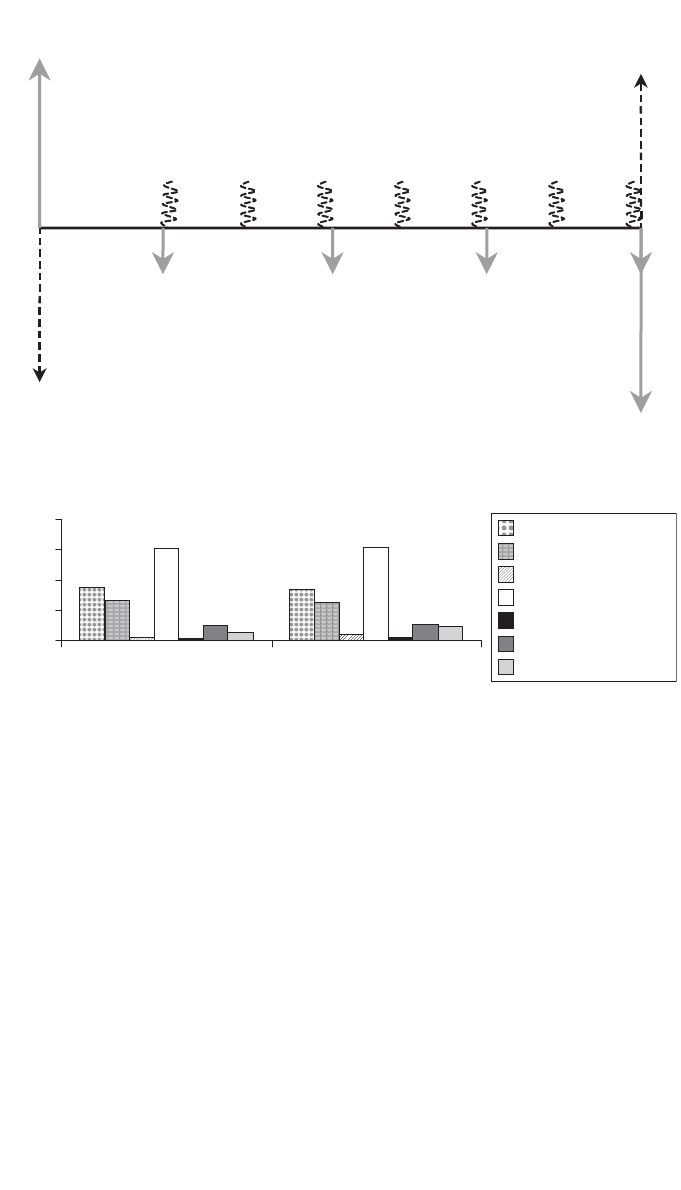
marketplace. We also look at the remaining types under the example of
the auto loan market for the reason that they are relatively homogenous
and stable. These activities are likely to serve as a template for the con-
tinued development of the European market.
4.2 Mortgage-backed securities
Most of you have familiarity with the mortgage arrangement. A loan is
provided which is backed with the underlying property of the subse-
quent purchase. Mortgages can be either fixed or floating rate. In the
US mortgages are generally amortizing. This means that the monthly
payment is composed both of interest and principal redemption.
Within the UK, possibly more heterogeneous than either the US or
Europe as a whole, there is a wide variety of possibilities including
184 Credit risk: from transaction to portfolio management
Fixed payments to the indenture
Receives
floating
Floating payments to the SPV
Pays fixed
Figure 4.3 The cash flows of an interest rate swap.
0
50
100
150
200
2002 2003E
Year
$ billion
Auto
Credit card
Equipment loan/lease
Home equity
Manuf. housing
Student loan
Other
Figure 4.4 Relative importance of different asset type by supply (May 2003).
Source: Barclays Capital.

interest only, typically with an endowment policy, or straight repay-
ment mortgages, also common are capped and fixed rate.
The capital markets, obviously, are not interested in individual debt
obligations. However if all of these obligations are pooled together then
the characteristics of the collection are often attractive. Such then is
the motive behind MBSs. In the US certain MBSs enjoy government
sponsorship; in which case the credit rating will be AAA. There are three
agencies which are either owned by, or have government association.
These are the Government National Mortgage Association (GNMA), the
Federal Home Loan Mortgage Corporation (FHLMC) and the Federal
National Mortgage Association (FNMA). The overwhelming majority of
mortgages will be financed by these agencies. Do not think however
that the consumer goes directly to the agency. They lend to intermedi-
aries. Table 4.1 illustrates the development of this phenomenon.
MBSs are issued both as ‘pass through’ and ‘pay through’ securities,
often referred to as CMOs. The latter formed by pooling ‘pass throughs’,
and redistributing the principal and interest according to a pre-set
formula.
‘Pass throughs’ represent an undiluted claim on the asset base. Cash
received by the vehicle (no distinction is made between interest and
principal) is passed directly on to the underlying securities. These all
have a single class structure, that is no holder has rights to the cash
flow that are senior or subordinated to the other holders (Figure 4.5).
There are a number of varieties of pass through which can be categor-
ized as ‘straight pass through’ whereby interest and principal is paid
directly to investors as it is received in the pool. ‘Partially modified pass
through’, where some payments may be delayed but ultimately covered
by the guarantee
2
and then the ‘modified pass through’ whereby all pay-
ments are made regardless of whether there is money in the pool. There
is also a type of pass through which categorizes the investors into two
groups the ‘callable’ and the ‘call class’. The latter receive nothing but
hold the right to call the security at a certain price and date in the future.
Securitization 185
Table 4.1 Issuance of MBSs ($ billion).
2003* 2002 2001 2000 1999
FHLMC 198 531 379 159 226
FNMA 410 727 524 213 299
GNMA1 51 111 109 59 108
GNMA2 19 63 67 46 46
Source: Bloomberg LP. *Until April 2003.
2
The guarantee must supply the extra funds.
Get Credit Risk: From Transaction to Portfolio Management now with the O’Reilly learning platform.
O’Reilly members experience books, live events, courses curated by job role, and more from O’Reilly and nearly 200 top publishers.

